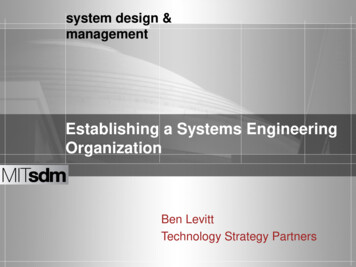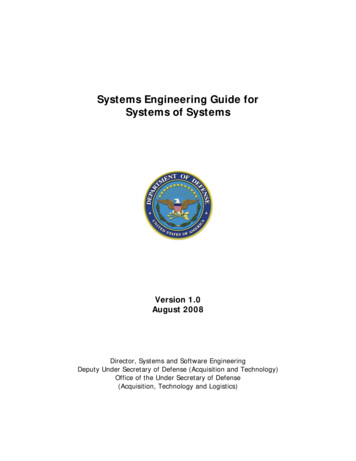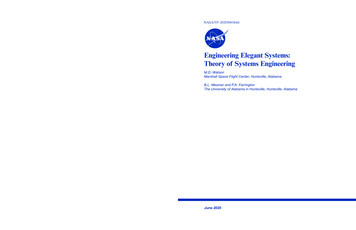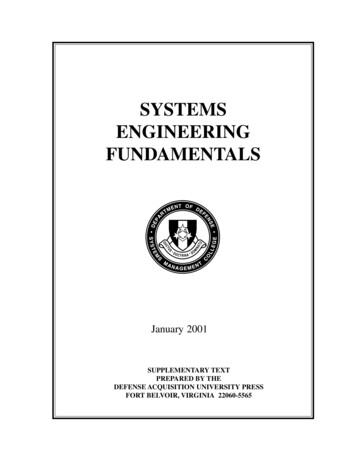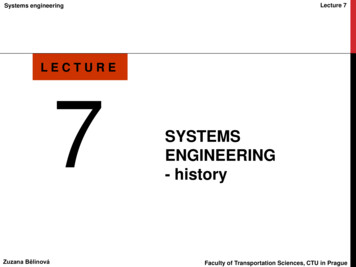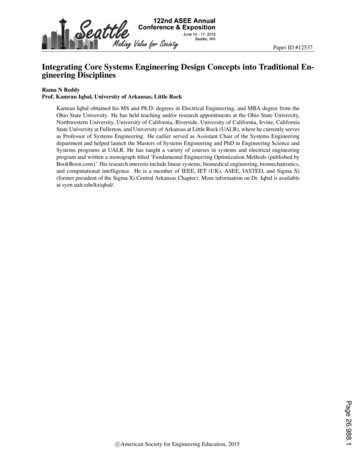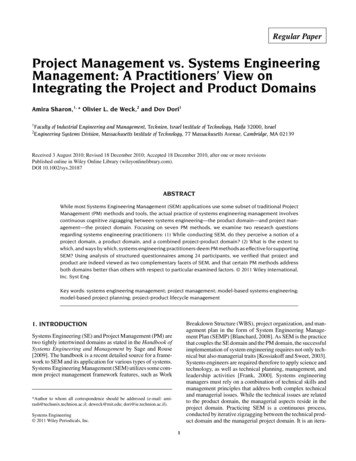
Transcription
Regular PaperProject Management vs. Systems EngineeringManagement: A Practitioners’ View onIntegrating the Project and Product DomainsAmira Sharon,1, * Olivier L. de Weck,2 and Dov Dori11Faculty of Industrial Engineering and Management, Technion, Israel Institute of Technology, Haifa 32000, IsraelEngineering Systems Division, Massachusetts Institute of Technology, 77 Massachusetts Avenue, Cambridge, MA 021392PROJECT MANAGEMENT VS. SYSTEMS ENGINEERING MANAGEMENTReceived 3 August 2010; Revised 18 December 2010; Accepted 18 December 2010, after one or more revisionsPublished online in Wiley Online Library (wileyonlinelibrary.com).DOI 10.1002/sys.20187ABSTRACTWhile most Systems Engineering Management (SEM) applications use some subset of traditional ProjectManagement (PM) methods and tools, the actual practice of systems engineering management involvescontinuous cognitive zigzagging between systems engineering—the product domain—and project management—the project domain. Focusing on seven PM methods, we examine two research questionsregarding systems engineering practitioners: (1) While conducting SEM, do they perceive a notion of aproject domain, a product domain, and a combined project-product domain? (2) What is the extent towhich, and ways by which, systems engineering practitioners deem PM methods as effective for supportingSEM? Using analysis of structured questionnaires among 24 participants, we verified that project andproduct are indeed viewed as two complementary facets of SEM, and that certain PM methods addressboth domains better than others with respect to particular examined factors. 2011 Wiley international,Inc. Syst EngKey words: systems engineering management; project management; model-based systems engineering;model-based project planning; project-product lifecycle management1. INTRODUCTIONBreakdown Structure (WBS), project organization, and management plan in the form of System Engineering Management Plan (SEMP) [Blanchard, 2008]. As SEM is the practicethat couples the SE domain and the PM domain, the successfulimplementation of system engineering requires not only technical but also managerial traits [Kossiakoff and Sweet, 2003].Systems engineers are required therefore to apply science andtechnology, as well as technical planning, management, andleadership activities [Frank, 2000]. Systems engineeringmanagers must rely on a combination of technical skills andmanagement principles that address both complex technicaland managerial issues. While the technical issues are relatedto the product domain, the managerial aspects reside in theproject domain. Practicing SEM is a continuous process,conducted by iterative zigzagging between the technical product domain and the managerial project domain. It is an itera-Systems Engineering (SE) and Project Management (PM) aretwo tightly intertwined domains as stated in the Handbook ofSystems Engineering and Management by Sage and Rouse[2009]. The handbook is a recent detailed source for a framework to SEM and its application for various types of systems.Systems Engineering Management (SEM) utilizes some common project management framework features, such as Work*Author to whom all correspondence should be addressed (e-mail: amirash@techunix.technion.ac.il; deweck@mit.edu; dori@ie.technion.ac.il).Systems Engineering 2011 Wiley Periodicals, Inc.1
2SHARON, DE WECK, AND DORItive process of planning, derivation, refinement, and simulation of both the product models and the management plans,while maintaining traceability and coherence between theproduct models and the project plan at all levels through thehierarchical structure of both the product and the project.The impact of systems engineering on program cost wasrecognized over a decade ago [DSMC, 1999], suggesting that,from the very early stages, careful management of the relationships between the product and the project is crucial to thesuccesses of a project that aims to deliver a defined product.Failure to closely manage the intricate web of resource constraints emanating from the two domains—the project and theproduct—for meeting the development and test objectives isa recipe for inadequate product performance and project timeand cost overruns. The identification and management of therelationships between the two domains is at the heart of SEMpractitioners. Empirical investigations have shown that therelationships and interactions between the architecture ofsystems, their development projects, and the organizationalteams involved, should be aligned in order for a company tobecome successful [Eppinger and Salminen, 2001].These observations call for a fresh look at the methods andtools systems engineering managers use in an attempt to bringthe product issues and the project issues together under thesame conceptual model of a combined project-product systemensemble. This is the premise of the Project-Product LifecycleManagement (PPLM) paradigm [Sharon, Perelman, and Dori,2008; Sharon, Dori, and de Weck, 2009], the context withinwhich this research was conducted. The PPLM approach isdesigned specifically with SEM in mind. The PPLM effortaims at developing a methodology and a support softwareenvironment for fusing the product to be developed with theproject to be executed by SEM practitioners.Focusing on seven researched PM methods, this paperpresents two research questions: (1) While engaged in systemengineering management, do practitioners perceive a notionof a project-domain, a product-domain, and a combined project-product domain? (2) How do systems engineers perceivethe extent to which each one of the surveyed PM methodssupports SEM?2. THE COMPARED PROJECT MANAGEMENTMETHODSThe need to concurrently address more than one domain hasbeen identified by Suh [1990], who developed the AxiomaticDesign (AD) methodology. AD addresses four domains: thecustomer, functional, physical, and process domains. Theoutput of each domain evolves gradually and hierarchicallyfrom an abstract concept into detailed information. The hierarchical decomposition in one domain cannot be performedindependently of the other domains; i.e., decomposition requires zigzagging in order to map adjacent domains to eachother. The planning process involves the continuous processing of information within and between the four domains. Thecustomer needs are identified in the customer domain and arestated in the form of required functionality of a product in thefunctional domain. Design parameters that satisfy the functional requirements are defined in the physical domain, andSystems Engineering DOI 10.1002/sysmanufacturing variables are defined in the process domain inorder to determine how the product is to be produced. The ADphysical domain is somewhat analogous to our product domain, while the AD process domain contains elements of ourproject domain. However, all the four AD domains focus tothe product. In our context of SEM and PM, the mentalzigzagging between domains entails switching back and forthbetween the product domain and the project domain. With thisrealization in mind, we have decided to conduct a comparisonsurvey of Project Management Methods, which are commonly used by systems engineering managers. These methodsinclude Work Breakdown Structure (WBS) [Department ofDefense, 1968], Product Breakdown Structure (PBS) [Officeof Government Commerce, 2005], Reliability, Availability,Maintainability (RAM) [Department of Defense, 2009],Critical Chain Project Management (CCPM) by Theory ofConstraints (TOC), resource scheduling, procurement techniques, contract bidding techniques, and risk managementmethods. Other traditional methods are Earned Value Method(EVM), Design Structure Matrix (DSM), System Dynamics(SD), Critical Path Method (CPM), Program Evaluation andReviewing Technique (PERT), and Gantt chart. The last methods, together with WBS, vary in terms of their objectives andapplications, and are the most referenced PM methods insystems engineering handbooks sources, indicating that theyare most commonly used within SEM. We have examinedseven PM methods—EVM, DSM, SD, CPM, PERT, Ganttchart, along with Object Process Methodology (OPM) [Dori,2002]—for answering our both research questions. See theAppendix for succinct description of the seven PM methods.The potential use of Object Process Methodology (OPM)for project planning and management has been studied in thecontext of the Project-Product Lifecycle Management(PPLM) framework [Sharon, Perelman, and Dori, 2008,Sharon, Dori, and de Weck, 2009], and is explored further inthis study. Originally used for modeling information systemsand for systems architecting and engineering, Object ProcessMethodology (OPM) has been found useful for project planning in combination with product systems representation. Itssuitability stems from its inherent capability to combine product- and project-based planning within a single Model-BasedProject Plan (MBPP). OPM is a formal yet intuitive conceptual modeling language with formal ontology, syntax, andsemantics. Specific extensions to OPM were defined as partof the PPLM research. Based on OPM’s formality, specificPPLM OPM-based templates were developed to be used formodeling of combined project-product plans.3. RESEARCH POPULATION AND SETTINGThe research population consisted of 24 mid-career systemsengineers from companies across the USA with an average of8.4 years of work experience. The participants were fromdifferent companies, covering a wide range of industry sectors, including defense, telecommunication services, automotive, medical systems, and electronic design automation. Theparticipants were among about 80 graduate students in theSystems Project Management course which is one of threecore mandatory courses in the Systems Design and Management (SDM) program at MIT’s Engineering Systems Divi-
PROJECT MANAGEMENT VS. SYSTEMS ENGINEERING MANAGEMENTsion. During the spring 2008 semester course, the researchparticipants studied the seven project management methodssurveyed in this study and practiced them through targetedhomework assignments, along with specific number of 3-hourclass sessions devoted to each method. Gantt and ObjectProcess Methodology (OPM) were not explicitly taught aspart of the course, since all participants were expected to haveprior knowledge of these methods. Gantt was assumed asbasic knowledge, and OPM was taught in a previous systemsarchitecture course. Nevertheless, a short reminder of Ganttand OPM in the course was followed by introduction toProject-Product Lifecycle Management (PPLM) and ProjectProduct Lifecycle Management (MBPP), which spanned 1.5sessions (4.5 h). The research was conducted through the fifthhomework (HW5) given in the course, which was nonmandatory. The 24 respondents elected to do HW5 and participatein the study. Some of their motivation was the option theywere given of having their final grade based on the best fiveout of six homework assignments.An Unmanned Aerial Vehicle (UAV) development projectcase [de Weck and Lyneis, 2008] served as a running casestudy for all the homework assignments. The project concernsdeveloping a UAV by a fictitious government-contracted leading UAV manufacturer.For their first homework (HW1), all the participants weretasked with creating a simple SD model and exploring itsbehavior. They examined the impact of uncertainties in project assumptions on cost and schedule.In HW2, they created a project plan using Critical PathMethod (CPM), drew a project graph, estimated the earlyfinish (EF) time of the project, and identified the critical pathand slack times. Using Program Evaluation and ReviewingTechnique (PERT), they had to analyze the impact of changesin individual task times on the critical path and considerprobability distributions of task times and their effect on theproject schedule.HW3 called for applying Design Structure Matrix (DSM).Participants first translated the project graph from the previous assignment to a DSM representation. Next, they addediterations to the project and analyzed their effect on theprevious task sequence. They then had to consider partitioning the DSM to reveal meta-tasks. Finally, they estimated theeffect of these changes on the critical path and estimatedproject completion time.For HW4, the participants focused on tracking projects andcomputing the various metrics defined in Earned ValueMethod (EVM) terms of cost and schedule in order to assessthe overall performance of the project and to critically analyzeand interpret the results.Finally, based strictly on the text given in a previoushomework assignment (HW2), HW5 called for creating twoproject plan versions, one using a Gantt chart model and theother using Object Process Methodology (OPM). In the second part of the homework the participants were asked tocompare the seven project management methods they hadstudied in the course with respect to a set of 14 projectmanagement factors, as described in the next section.34. RESEARCH METHODOLOGYSince the investigated project management methods weretaught in the course during lectures and practiced throughhomework assignments, we assumed that the participants hadan identical minimal level of working knowledge of thesemethods. Since they were all practicing system engineers, theactual level of most of them was likely higher than thisminimal assumed level.The same system project case—the Unmanned Aerial Vehicle (UAV)—served as the basis for all the assignmentsthroughout the entire course (except for the final projects). Ateach assignment the participants had to deal with anotheraspect of the same case. Had the experience the participantsgained in applying all seven methods been drawn from different system projects, the influence of changing cases wouldnot be separable from the applied methods.4.1. The 14 SEM Factors and Their DimensionsRecognizing that systems engineering management entailsboth the product and the project viewpoints, we defined 14factors, F1–F14, that account for both major classical projectmanagement issues and aspects of the joint project-productensemble, which is at the focus of Systems EngineeringManagement (SEM).The set of 14 factors was determined using an evaluationsurvey among practicing systems engineers, who were askedto select the most suitable factors from a larger amount ofcandidate factors. The extent of relevance of each one of thecandidate factors to SEM was ranked by 20 practicing systems engineers, with average of 13.7 years of work experience, employed in a large enterprise dealing withdevelopment of diverse large-scale systems in the defenseindustry. The practitioners were asked to grade the extent ofthe relevance of each factor for the project domain and for theproduct domain, using a semi-Likert scale [Likert, 1932] of1–5, where 1 is very little, 2 is little, 3 is moderate, 4 is high,and 5 is very. Not applicable was denoted by 0. The practitioners were not instructed to relate either to a specific projector product or to a specific scale of projects or products.Therefore, their rankings present a subjective judgment oftheir perception of each factor’s extent of relevance for eachdomain. The medians of the rankings were calculated and seta threshold of 75% for the selection of factors to be used inthe next research step. Using medians and the threshold hasyielded a list of the 14 factors that were most agreed upon assuitable among the first-stage participants. The medians obtained for the 14 factors that passed the threshold span from3.88 to 4.75, as shown in Table II. No significant differencewas found between the rankings of both domains—the projectand the product. This might indicate that, in the environmentof large-scale project-product ensembles of the type the practitioners are involved in, the project and the product arestrongly intercorrelated, resulting in only a nonsignificantdifference. The surveyed Unmanned Aerial Vehicle (UAV)case, presented in this paper, is also in the ballpark of largescale ensembles, though it was not actually conducted by theparticipants in a real enterprise environment.Table I lists the 14 factors and their meaning, together witheach factor’s latent dimension. The set of all 14 factors to-Systems Engineering DOI 10.1002/sys
4SHARON, DE WECK, AND DORITable I. The 14 Systems Engineering Management Factorsgether forms the SEM dimension, DSEM, as defined in Eq. (1).Four of the 14 SEM factors belong to the “classical” projectmanagement domain and are indeed addressed by commonproject management methods; therefore, they are categorizedin the project dimension, Dproject, as defined in Eq. (2). Fourother factors fit traditionally in the product domain; hencethey are categorized in the product dimension, Dproduct, asdefined in Eq. (3). The remaining six factors are common tothe combined product-project domain, Dproject-product, definedin Eq. (4), as they cannot be uniquely associated with eitherthe product alone or the project alone. With respect to riskmanagement, we have adopted NASA’s view of this issue ascommon to the project and the product domains [NASA,1995]. This approach is founded on the premise that there aretechnical risks, which are mostly in the product domain, andmanagerial risks, which are mostly in the project domain. Thisis contrary to the approach of leading standards IEEE Standard 1220 [IEEE, 1994] and ANSI/EIA Standard 632[ANSI/EIA, 1999], which view risk management primarily asa managerial issue and therefore relate to it as project domainissue. A fourth dimension, DCombined project-product, is also defined in Eq. (5) for analysis reasons—this is a combination ofthe factors of Dproject and Dproduct.The classification of the 14 factors is as follows:Systems Engineering DOI 10.1002/sysDSEM {F1, F2, . . . , F14},(1)Dproject {F1, F2, F4, F11},(2)Dproduct {F6, F7, F8, F9},(3)Dproject – product {F3, F5, F10, F12, F13, F14},(4)DCombined project – product {F1, F2, F4,F6, F7, F8, F9, F11}. (5)4.2. The Survey Questions and Their AnalysisMethodThe 14 factors were introduced to the participants in therandom order listed in Table II. The participants were notinstructed in any way to think specifically of the considerations as related to “project,” “product,” or “project-product”dimensions. Our aim was to explore whether their unguidedperceptions towards the different factors would reflect recognition of these factors as related to our three predefined latentdimensions of “project,” “product,” and “project-product.”
PROJECT MANAGEMENT VS. SYSTEMS ENGINEERING MANAGEMENT5Table II. The 14 Factors Extent of Relevance for SEMThe participants were instructed to rank each one of the 14factors for each one of the seven systems engineering management methods using the same Likert scale [Likert, 1932]as before.Since the participants were practicing systems engineers,their views of the project management tools tended to reflectthe application of these methods in systems engineering management more than in project management. To examine theparticipants’ views of each project management method withrespect to each factor, we compared the responses for eachone of 14 factors with respect to each one of the seven PMmethods.To determine whether our classification of the 14 factorsinto the three domains can be verified by the research participants’ responses, we first analyzed the grades they had givenfor each factor and method combination. Using the AlphaCronbach coefficient [Cronbach, 1951], we determinedwhether the domain-categorized factors can be considered tobe a distinct dimension.Using (6), the Alpha Cronbach coefficient α is calculatedfor estimating how well a set of variables measures a single1-dimensional underlying construct. k is the number of items,σ2i is the variance of the ith item, and σT is the variance of thetotal score formed by summing all the items of the testedsample. The result obtained from (6) determines the internalconsistency of items within a single test, indicating reliability.The reliability is in terms of the ratio between the true scorevariance of the “underlying construct” and the observed scorevariance of that unidimensional construct, where the construct is the hypothetical variable that is being measured[Hatcher, 1994]. α ranges in value from 0 to 1, when 0.70 isdefined [Nunnaly, 1978] as the cutoff value to be an acceptable reliability. It increases when the average intervariablecorrelation increases. Therefore, high values of α provideevidence that the variables included in its calculation measurethe same underlying construct.kα k 1k 22 1 σσ/ iT . i 1 (6)The sum of all the participants’ Likert scale rankings foreach factor was calculated, and the sum of all 14 factors foreach PM method was taken as that method’s score. The αvalues for each PM method were calculated from the Likertscale results for each group of factors defined for each domain, namely, Dproject as defined in (2), Dproduct as defined in(3), Dproject-product as defined in (4), and DCombined project-productas defined in (5).5. RESULTS AND ANALYSISWe present and discuss the comparison of results of participants’ rankings of the seven surveyed PM methods withrespect to the 14 project management factors listed in TableII.5.1. Methods Comparison by FactorsUsing (6), α was initially calculated for all 14 factors, aspresented in the first row, DSEM, of Table III. The results arehigher than 0.70 for all but the Design Structure Matrix(DSM) method. Therefore, we can use the participants’ rankings for all the 14 factors for the sake of comparison betweenthe six PM methods, from which DSM is excluded. Whenexcluding two factors from Dproject-product—F12 (InformationResolution Level) and F3 (Interrelationships, process & product)—DSM exceeds an α value of 0.7. Excluding these twofactors for all the seven PM methods, we are left with a set of12 factors that can be reliably used for the comparison of allthe seven PM methods.Figure 1 represents by the dark bars the sum of scores ofthe 14 factors participants assigned for each method. ObjectProcess Methodology (OPM) scored the maximum sum, 885points. A cutoff value of 664 points, which is 75% of thisSystems Engineering DOI 10.1002/sys
6SHARON, DE WECK, AND DORITable III. Cronbach’s Alpha Results for Factors Combinationsmaximum score, leaves us with three methods: Object ProcessMethodology (OPM), System Dynamics (SD), and EarnedValue Method (EVM).The light grey bars in Figure 1 represent the sums ofrankings of the 12 factors (where F3 and F12 are excluded).With these 12 factors, SD scored the maximum sum, 769points. Assigning a cutoff of 577, which is 75% of thismaximum, leaves four methods in the game: OPM, SD, EVM,and DSM. The sum of all the participants’ rankings for eachfactor was calculated, and the sum of the 12 factors for eachPM method was taken as that method’s final score.5.2. Dimensions AnalysisWe present and discuss the results of α calculated for the fourdimensions Dproject, Dproduct, Dproject-product, and DCombined project-product.5.2.1. The Project DimensionBased on the participants’ rankings for the four factors ofDproject, α was calculated for each PM method, and is presented in Table III. Since we evaluated project managementmethods, we expected α results with value of .70 or higher tobe obtained for all seven methods, indicating that the factorsin the underlying project domain are handled by all the sevenPM methods. Surprisingly, however, as Table III shows, suchabove-the-cutoff values were found only for four PM methods: System Dynamics (SD), Program Evaluation and Reviewing Technique (PERT), Design Structure Matrix (DSM),and Object Process Methodology (OPM). The remainingthree methods, namely, Critical Path Method (CPM), EarnedValue Method (EVM), and Gantt, did not pass the 0.70 αcutoff acceptance value. Even for the best improved result,which was obtained by removing F11—iterations management—these three methods still remain below the 0.70 cutoffvalue.5.2.2. The Product DimensionApplying a similar analysis for the product domain, we calculated α for the four factors of Dproduct for each PM method.As Table III shows, the product dimension was found acceptable for three methods: System Dynamics (SD), Object Process Methodology (OPM), and Design Structure Matrix(DSM). The latter got in as having a product dimension onlyafter removing F8—product planning.Figure 1. Project management methods comparison by sums offactors rankings.Systems Engineering DOI 10.1002/sys5.2.3. The Project-Product DimensionThe project-product dimension was found to characterizeonly two methods: Earned Value Method (EVM) and ObjectProcess Methodology (OPM) (see the third row in Table III).The results reflect the participants’ perception that only thesetwo methods have an underlying project-product dimension.
PROJECT MANAGEMENT VS. SYSTEMS ENGINEERING MANAGEMENT7Figure 2. Project management methods comparison by dimensions.In view of the small number of methods found for theproject-product dimension, we also examined the combinedproject-product domain DCombined project-product. Although nosuch underlying dimension was predefined in the surveydesign, the participants’ rankings that yielded α value of 0.70or higher might potentially reflect that the project and productdimensions are cognitively inseparable. This sits well with theresults obtained in the gauging survey discussed earlier. Aspresented in the fourth row of Table III, the combined projectproduct dimension was found for Object Process Methodology (OPM), System Dynamics (SD), Design Structure Matrix(DSM), and Program Evaluation and Reviewing Technique(PERT). The latter became acceptable after elimination ofF8—product planning—even though for the product dimension it had not reached the cutoff value.The project dimension scores (darkest grey bars, ΣDproject)are higher than the product dimension scores (lightest greybars, ΣDproduct – Σ{F8}) for all the three PM methods. Thescores of the combined project-product dimension (dark greybars, ΣDCombined project-product – Σ{F8}) are reasonably situatedbetween the project and the product dimension scores. OPMscored the highest in three dimensions—project dimension,product dimension, and the combined project-product dimension. While for SD and DSM, the project-product dimensionscores are higher than those of the combined project-productdimension, the result is reverse for OPM. This may indicatethat the dimensions perception is more complex: for OPM, aproject-product dimension is acceptable, but the separateproject dimension and product dimension are not only accept-5.3. Methods Comparison by DimensionsComparison of the seven PM methods by dimension can beconducted with the methods for which all dimensions werefound––SD, DSM, and OPM. The comparison, presented inFigure 2, is based on calculated sums of scores participantsassigned to each factor for each PM method, as listed in TableIV. Each relevant total sum STotal was divided by the quantityof factors used for calculating that sum. The sum of all 14factors, STotal for ΣDSEM, is not applicable for DSM since onlyby excluding F12 and F3 did it pass the 0.70 threshold. Thesame rationale was followed when excluding factors for reliably calculating the sums for ΣDproject-product and for ΣDCombined project-product. In addition, the sum of the productdimension factors, STotal for ΣDproduct, was calculated for allthree methods without F8, since DSM got in as having theproduct dimension only after removing this factor.Based on the data presented in Table IV, Figure 2 showsfor each of the three methods in the table the sum of scoresparticipants assigned to that method, for each one of thedimensions. The values on the vertical axis represent thenormalized total sum, which is STotal divided by the numberof factors, for each PM method.Table IV. Sums Calculations for Comparison of Methods byDimensionsSystems Engineering DOI 10.1002/sys
8SHARON, DE WECK, AND DORIable, but also rank higher. For SD and DSM the perception ofdimensions is reversed.5.4. DiscussionDue to the diversity of the Systems Engineering Management(SEM) vocation and the wide range of practitioners’ trainingand experience, it is very difficult, if at all possible, to find agroup of systems engineers who are homogeneous in theirknowledge and application of the traditional Project Management (PM) methods. On top of this, a group of systemsengineers who are familiar with Object Process Methodology(OPM) in addition to the traditional PM methods had to beidentified. This is hardly achievable since model-based project planning is still being developed, and OPM is not yetwidely used for constructing a model-based project plan.Fortunately, the 24 midcareer systems engineers who studiedin the SDM graduate program at MIT and constituted ourresearch group meet these criteria. We encouraged the participants to reflect on their work and provide criticism, and sothey did. Most participants noted that the Model-Based Project Plan (MBPP) approach seemed promising but was not yetmature to be usable in practical applications. Nevertheless,when the participants ranked the PM methods with respect tothe given set of factors, their judgment reflected a favorableattitude towards MBPP. Since the participants were asked torecord the duration of the modeling tasks using Gantt andOPM, their reflections indicated that they had thought we arecomparing modeling durations rather than our more subtleresearch goals. Given these, we can exclude potential bias infavor of MBPP.Although the participants were not instructed to group thefactors in any specific way, they cognitively combined thefactors in a way that three out of the seven examined methods—System Dynamics (SD), Design Structure Matrix(DSM), and Object Process Methodology (OPM)—werefound to handle well both the project dimension and theproduct dimension. This outcome is different than the oneobtained in the gauging s
Systems Engineering Management (SEM) utilizes some com-mon project management framework features, such as Work Breakdown Structure (WBS), project organization, and man-agement plan in the form of System Engineering Manage-ment Plan (SEMP) [Blanchard, 2008]. As SEM is the practice that couples the SE domain and the PM domain, the successful
